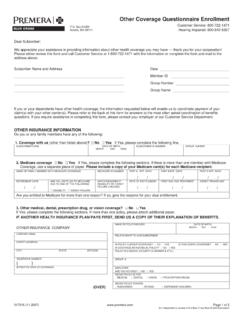Transcription of 1.01.529 Durable Medical Equipment - Premera Blue Cross
1 UTILIZATION MANAGEMENT GUIDELINE Durable Medical Equipment Effective Date: April 1, 2022 Last Revised: Mar. 21, 2022 Replaces: N/A RELATED Medical POLICIES: Wheelchairs (Manual or Motorized) Patient Lifts, Seat Lifts, and Standing Devices Durable Medical Equipment Repair/Replacement Power Operated Vehicles (Scooters) (Excluding Motorized Wheelchairs) Children s Therapeutic Positioning Equipment Non-covered Services and Procedures Select a hyperlink below to be directed to that section. COVERAGE GUIDELINES | DOCUMENTATION REQUIREMENTS RELATED INFORMATION | EVIDENCE REVIEW | REFERENCES | HISTORY Clicking this icon returns you to the hyperlinks menu above. Introduction Equipment that is used to help a patient heal from a certain Medical condition and/or illness is called Durable Medical Equipment .
2 The Equipment is mainly used for a Medical purpose and would not be useful to someone without an illness, disability , or injury. These items are ordered or prescribed by the patient s doctor or health care provider and are reusable; they can be used in the patient s home . While there are many others, some examples are wheelchairs, canes, crutches, walkers, ventilators, monitors, and lifts. This policy explains when Durable Medical Equipment is covered. Note: The Introduction section is for your general knowledge and is not to be taken as policy coverage criteria. The rest of the policy uses specific words and concepts familiar to Medical professionals. It is intended for providers. A provider can be a person, such as a doctor, nurse, psychologist, or dentist. A provider also can be a place where Medical care is given, like a hospital, clinic, or lab.
3 This policy informs them about when a service may be covered. Coverage (03-21-2022)Page | 2 of 12 Please see the definition of " Durable Medical Equipment " in the member's plan document for the purpose of making benefit determinations. Equipment Medical Necessity Durable Medical Equipment Durable Medical Equipment (DME) also known as home Medical Equipment (HME) may be considered medically necessary when ALL of the following criteria are met: The patient has a documented physical functional impairment or disability due to disease, trauma, congenital anomaly, or prior therapeutic intervention and requires accommodation for basic activities of daily living (ADLs) that can be met by using a DME item AND Documentation in the Medical record contains a clinical assessment and rationale for the requested DME item (see Documentation Requirements) AND The DME is prescribed by a health care practitioner AND The piece of Equipment meets the definition of DME (see Definition of Terms) AND The requested DME item is not considered investigational or unsafe by a regulatory agency, and is not excluded by plan benefits or considered a contractual exclusion Durable Medical Equipment (DME)
4 Is considered not medically necessary when the above criteria are not met. The following are considered not medically necessary: Accessory add-ons and upgrades when a basic (standard) DME item meet the member s functional needs Deluxe Equipment when basic (standard) Equipment is available and meets the member s functional needs Duplicate Equipment that meets the same functional need (eg, a rolling walker, when the member has a properly fitted cane) Elastic garments (eg, stabilizing pressure input orthoses SPIO) Page | 3 of 12 Equipment Medical Necessity Equipment and modifications/upgrades to Equipment when used primarily for leisure or recreational activities (eg, special wheelchair wheels for sport activities, adaptations for beach use, skiing, and others) Redundant or back-up DME item(s)
5 Not used as the primary device to meet the member s functional needs (ie, more than one of the same item of Durable Medical Equipment ) Note: While there are items that are typically considered convenience devices, in certain situations, these same items may serve a medically therapeutic purpose. Requests for such items will be reviewed for Medical necessity. The following are covered without review: Speech generating devices (SGDs) A software program to be used with a personal device for essential communication Artificial laryngeal devices (prosthetic) Durable Medical Equipment may include the following: Purchased Equipment when the purchased DME is less expensive than the rental of the Equipment or if the DME is not available for rental Rental charges for the DME if rental is less expensive than the purchase price of the Equipment Repair, adjustment, or replacement of parts and accessories necessary for the normal and effective functioning of the DME (see Related Policies).
6 Equipment Non-Covered Durable Medical Equipment Durable Medical Equipment is not covered when: It is considered experimental or investigational or used for experimental or investigational therapy or interventions It is associated with athletic, scholastic, educational/vocational training of the patient It does not meet a Medical need and is dispensed by a DME supplier without a prescription Page | 4 of 12 Equipment Non-Covered The following are considered non-covered items: Athletic/exercise/physical fitness Equipment (eg, treadmills, stationary bikes) (eg, ROMTech rehabilitation device) Altered auditory feedback (AAF) devices to treat individuals who stutter are considered investigational Comfort or convenience items added to basic (standard) Equipment Equipment used for environmental control or to enhance the environmental surroundings (eg, air conditioners, air filters, humidifiers, allergy protective pillow/mattress covers, furniture [eg, recliner chairs, over-bed tables], and others) First aid or precautionary Equipment (eg, automatic external defibrillator [AED]) home modifications (eg, bath grab bars, electronic door openers, elevators, Jacuzzi/whirlpools, ramps)
7 Institutional Equipment (eg, any DME that is used only in a Medical facility and is not suitable for use in the home setting) Maintenance and service fees for DME Multiple-function hardware devices that do not meet the definition of Durable Medical Equipment (DME), because they are not primarily intended for Medical purposes, include but are not limited to: o Desktop and laptop computers o Personal digital assistants (PDA) o Smartphones o Tablet computers o Internet or phone services Vehicle modifications (eg, wheelchair vans, lifts attached to vehicles for scooters or wheelchairs) Note: If there is a specific DME item addressed in another policy please refer to that policy. Page | 5 of 12 Documentation Requirements Medical necessity for a DME item is determined by the patient s current condition and not by probable deterioration in the future.
8 There are varying degrees of Medical conditions, and these Medical conditions may contribute to the member s underlying problem and need for home Medical Equipment . Patients should have a face-to-face clinical evaluation with a physician, or other qualified professional to assess their home Equipment needs. Documentation from the clinical evaluation should include the following: o An order/prescription from the physician/health care provider responsible for the patient's care that states the therapeutic purpose of the DME AND o Details of the patient s physical functional impairment related to completing activities of daily living (ADLs) without the home Medical Equipment /DME AND o The patient's Medical condition that requires DME for long term use (ie, 6-12 months or more) when applicable AND o What assistive devices (eg, canes, walkers, manual wheelchairs) the patient has trialed and found inadequate/unsafe or contraindicated to completely meet their functional needs (when applicable) Note.
9 Even when a provider orders or prescribes DME and deems the Equipment necessary for the patient s functional needs, that does not mean that the item meets the criteria as listed in this guideline. It also does not guarantee that the item will be considered medically necessary by the Plan. Related Information Definition of Terms Activities of daily living (ADLs): Self-care activities done daily where a person lives that include: Ambulating (walking) Bathing/dressing Eating Page | 6 of 12 Hygiene/grooming Toileting Transferring Convenience items: Equipment that serves no Medical purpose or that is primarily for comfort/convenience. These items are excluded from coverage under most health plan benefits. Durable Medical Equipment (DME): Consists of items that are: Appropriate for and primarily used in the home setting Designed to be long-lasting and can stand repeated use ( Durable ) Not implantable in the body Not solely for the convenience of the patient or caregiver Not useful to a person without an illness or injury Ordered or prescribed by a physician or other qualified provider Primarily and normally used to serve a Medical purpose Reusable (non-disposable) Homebound: A homebound person has a condition that impairs their ability to leave home independently and as a result, leaving home requires a taxing effort.
10 The patient may leave home , but the time away should be short, infrequent, and mainly for receiving Medical treatment. Homebound status may be applied to people with poor resistance to disease or have such poor health that reverse isolation precautions are recommended by their providers to avoid exposure to infection. Examples of a poor resistance to disease may include but are not limited to: Patients undergoing chemotherapy, or Patients with a chronic disease that has lowered their immune status or Premature infants Homebound status also applies to those members that require assistance when performing activities of daily living. Note: Homebound status is not determined by the lack of available transportation or inability to drive. Page | 7 of 12 Instrumental activities of daily living (IADLs): Activities related to independent living but not always done on a daily basis and include: Communication (using the phone, computer, or other communication devices) Housework/ home maintenance Managing personal medications Managing personal finances Preparing meals Shopping (for basic necessities) Transportation (driving or using public transit) Mobility limitation: A limitation that.
















